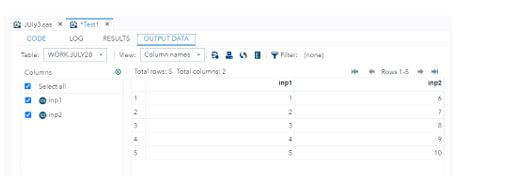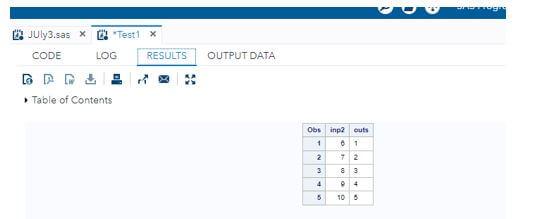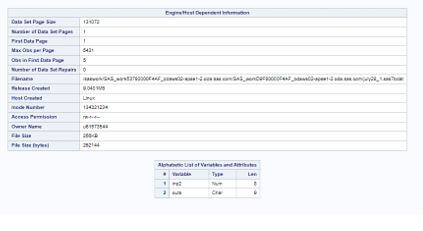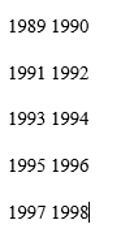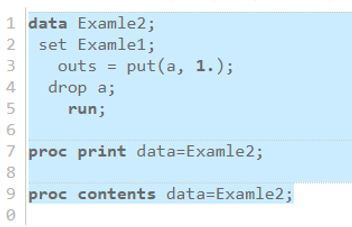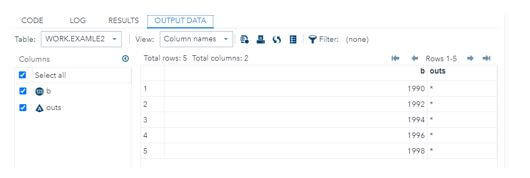Updated March 17, 2023
Introduction to SAS Numeric to Character
The SAS numeric to character is the type of format. It’s a value that helps to perform the put operations in the SAS to say the original value in the specific same original variable, and also the format should be the same type as the original variable likewise with the help of the put () method the character variable, and its value is converted to the numeric type.
Key Takeaways
- To convert the numeric to the character, we can use the vars= put (vars1, format), which tells us to apply the variable’s original value.
- It should be the same type that is on the original variable values.
- The length statement must be needed to create the new and explicit variables.
- The maximum variable character length of the SAS is 32,767 bytes; depending upon the data analysis requirement, it will be raised.
- The data difference will be calculated at least on two different dates.
Overview of SAS Numeric to Character
Whenever we need to enter the value in a specific set of variables, that may call the inputs. To convert the numeric values to the character inputs, we can use the put () method for converting the numeric format to the character format. The main format helps to use the SAS format to apply the values as it is in the original variable and should be of the same type as the original variable.
The primary condition is the format should be of the numeric type, and these steps are more needed in the numeric value in the integer format. Parallelly the Input function is also used to convert the values for the same numeric format to character format. The variable should be of a single type; it cannot be used as the same variable name for converting the values. When we use the functions below, it will create a new variable with the converted values resulting from the original variable name to drop the same and rename the new variable to the old variable.
How to Use Converting SAS Numeric to Character?
It has a set of formats for performing the Analytical operations and datasets in the SAS, as SAS informat is the component for the SAS numeric format for reading the specific data. And also, the Input statement is used to define the variable additionally. (dot) the operator is mainly placed at the informat end and differentiates the SAS for the other variables. So SAS informat method will instruct and teach how to read the input datas in the SAS variables.
Steps to convert the SAS numeric to character inputs:
1. Navigate to the below URL.
3. Paste the below code as an example to create the numeric dataset.
4. data July 28;
5. input inp1 inp2;
6. datalines;
7. 1 6
8. 2 7
9. 3 8
10. 4 9
11. 5 10
12. ;
13. run;
14.
15. proc print data=July28;
16. Then, we need to use the put () method to convert numeric inputs to the character format.
17. data July28_1;
18. set July 28;
19. outs = put(inp1, 9.);
20. drop inp1;
21. run;
22.
23. proc print data=July28_1;
24.
25. proc contents data=July28_1;
26. Additionally, we can see the Alphabetic List of variables and Attributes in the SAS.
SAS Numeric to Character INPUT()
First, we need to create the dataset in the SAS, which has some amount of datas for each set of variable columns; it may be the consecutive inputs or dynamic datas. Then, with the help of proc contents, we can view the data type of the specific variables below.
In the above screenshot, we can see the two sets of variables like inp2 and outs. One, the inp2, is the numeric type with the length of 8, and another is outs; it’s a character datatype with nine length characters. The typecasting applies for both types, like numeric to character and character to numeric, with additional operations like multiplying each set of input characters’ length line by line.
Example of SAS Numeric to Character
Given below is the example of SAS Numeric to Character:
Code:
data Examle1;
input a b;
datalines;
1989 1990
1991 1992
1993 1994
1995 1996
1997 1998
;
run;
proc print data=Examle1;
data Examle2;
set Examle1;
outs = put(a, 1.);
drop a;
run;
proc print data=Examle2;
proc contents data=Examle2;Output:
1. In the above example, we create the dataset on the inputs as the year format starting from 1989 to 1998.
2. Then, after creating the SAS dataset with the above inputs and need to perform the SAS numeric into character format.
3. With the help of the SAS put() method, we can convert the inputs to the character format.
We can also use the proc contents to get more details on the SAS typecasting or conversions. For example, in the above screenshot, we can see the outs column only displayed the * character because of the digits of the input, like 1. i.e.) convert 1 to character format on variable inputs.
Frequently Asked Questions
Other FAQs are mentioned below:
Q1. What is numeric in SAS?
Answer:
The numeric is the SAS data type used to specify the numeric variables on the SAS dataset. And it is mentioned in the data step.
Q2. What is a character in SAS?
Answer:
SAS character is the type more specified on the character type of variables and is defined in the data step.
Q3. How will you convert the numeric to the character in SAS?
Answer:
With the help of the put () method, we can convert the numeric to the character type.
Q4. What is the difference between Input and Put?
Answer:
- Input() is the method used to convert the character to numeric.
- Put() is the method used for converting the numeric to a character.
Q5. What is the syntax for numeric-to-character conversion?
Answer:
Variable = put(originalvariable, format_)Conclusion
The SAS numeric to character is the typecasting, and it is used to perform the data conversion from one type to another with default methods. The put () method is used for converting the numeric to character type output is the string return type for justifying the inputs.
Recommended Articles
This is a guide to SAS Numeric to Character. Here we discuss the introduction, how to convert SAS numeric to the character, and examples and FAQ. You may also have a look at the following articles to learn more –


